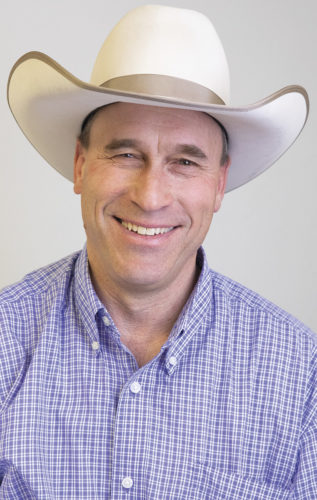Although the allotment consists of four or five different units and several thousand acres, it seems no matter where the cows start – Lake Creek, Summit Creek, Second Carson or Mill Canyon – within two or three days, a good share of them will hustle up to the top of the mountain, work their way through a couple of fences and some pretty rough country, and find their way to the other side of the mountain to the range cow paradise of Almo Park.
This annual migration routinely causes me a fair amount of cowboy angst. Almo Park is, appropriately, on the Almo side of the mountain. It’s not part of our allotment. So my anxiety is certainly warranted when the cows wander into the forbidden depths of the king’s forest.
The Almo Park unit is better cow country than any of the country in our allotment. It slopes down from the top into seemingly endless little meadows, surrounded by groves of quaking aspen with little springs in nearly every grove – good grass, good water, and a cow doesn’t have to travel a mile or two to find either commodity.
It seems once a cow has had a taste of the Almo Park experience, its lust for it is never extinguished. The euphoria of it seems to be permanently branded into the bovine’s brain like the memory of a first kiss on homecoming night.
To gather cows out of Almo Park, push them back up over the top and get them to stay where they belong requires a herculean effort. Once you find a few cows, they’ll scatter in forty-eleven directions through the trees the second you try to move them.
They seem to literally disappear into the darkness of the trees, snuffing out any light from the tiny flame of hope you might have had when you first rode up on them.
You can hear them all around you, part sneaking, part crashing through the trees and brush. You may know they’re there, but you can’t see them. It really is, quite often, a demoralizing effort in futility.
If you start with 30 head, you’ll be lucky to make it out of the trees and through the gate with six. Somehow, we eventually seem to get all of the wandering lasses gathered and homeward bound, even though the route and method of reaching the end goal almost never follows the original plan.
During my growing up years, my family dabbled in about any animal agriculture enterprise that might lose some money. In addition to the beef cows we also had, like many of our neighbors, a little herd of milk cows and ran a small mink operation.
As if that was not enough, when I was about 14, I got into the pig business. I kept a few sows and sold weaner pigs and an occasional slaughter hog to the locals.
Like any farm kid, I still have memories of every variety – poignant and fond, painful and sad – of the hours, days and weeks spent doing chores or taking part in the seasonal rituals of farm and ranch life. Branding or spring turnout, or the fall gather, or weaning or shipping calves, though rarely stress-free events, always carried with them an air of eager anticipation.
Other things, like milking heifers for the first time in the old flat parlor, hauling and spreading manure from the pit on winter weekends, haying season or just about anything to do with the mink, were greeted with equal parts dread and loathing – and a dash of excitement that accompanies any change in the regular routine.
Some of the enduring memories of the winters of my younger years are of the late evenings spent in the pelting barn skinning mink. From the time I was about 7 years old until I left home to go to college, I’d help my dad skin mink every day after school until well after dark.
As I look back now, I realize it probably wasn’t as late into the night as it seemed at the time, but the cold, short days of winter have always seemed to lend a few extra minutes to each long hour of the winter darkness.
The pelting barn was about 100 yards from the house. We didn’t have any yard lights, so when you walked out of the barn, you had to be prepared to deal with near-total darkness depending on the stage of the moon. My dad taught me a trick, early on, when I was just a little kid who was maybe a little scared of the dark.
He told me to close one eye for about 30 seconds before we turned out the lights. That would enable the closed eye to see when we stepped out into the dark night. He let me know that, even though I may not have always been able to see it, there was always some light out there somewhere.
I have gradually learned how to be thankful for that awareness, as well as a pile of other underappreciated blessings. Whether it’s a frustrating afternoon spent chasing after ghost cows under a canopy of quakies and conifers or suffering through my darkest, error-filled hours, shrouded in doubt, I will always know the light is still there. ![]()

-
Paul Marchant
- Writer
- Progressive Cattleman
- Email Paul Marchant








